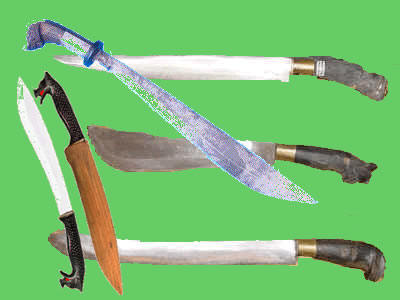The Bolo - An indispensable Utensil in the Philippine Household
I catch my Philippine wife again and again as she tries to cut a cucumber, an onion, bread with the longest available knife. Then mostly I cant avoid to make the mocking remark: You can kill a calf with this knife" However, my wife holds firmly on to her Philippine bolo tradition because a Philippine household has indeed at least two bolos, one for the kitchen and one for the coarse and dirty things outside the house. With help of a bolo you can for example open coconuts, fell banana trees or remove annoying undergrowth. On the country side farmers can often be seen with a bolo fixed to the leather belt.
However, there are a lot of variations. Depending on the purpose bolos can be shorter or longer. The blade may be straight or turned. A bolo is often widened shortly before its end to give the stroke more power. Bolos ending in a sharp tip were frequently used in military combats. The steel has different grades of quality - sometimes it still shines, sometimes it is already rusted. Improvisation is necessary in the Philippines; therefore bolos are also made from leaf springs. The grip or hilt can be decorated with ornaments; it can be straight or can have a pommel. It is manufactured from metal, (hard) wood or cheap plastic. The protection covers can be very simple, while more expensive covers show ornaments.
T Another use is more peacefully. Often Filipinos can be seen, cutting their thin grass in the front garden with a bolo. Who knows - if I should be obliged to do such a work, perhaps I would run amok .... © Wolfgang Bethge, 2007 (1) Philippine History Group, The Balangiga Massacre: Getting even, in: http://www.bibingka.com/phg/balangiga/default.htm
|
 T
T he Bolo is a fight instrument of the Filipino Martial Arts which are better known as Kali, Arnis or Escrima. It belongs to the inventory of the Philippine hero mythology. Already in prehistoric time it served to slit bodies and to chop heads off or to split them. For the "Katipuneros" freedom fighters it was often the only weapon in their fight against the Spanish troops. The very popular heroes Lapu-Lapu and Bonifacio are often shown with a bolo. Bolos were also used in the Philippine-American-War (1899 -1902). During the Balangiga massacre (1901) Philippine women smuggled bolos in child coffins to the insurgents (1). Later, the 1st Philippine regiment of the U.S. Army was called "Bolo Battalion". It fought in underground against the Imperial Japanese troops in the 2nd World War.
he Bolo is a fight instrument of the Filipino Martial Arts which are better known as Kali, Arnis or Escrima. It belongs to the inventory of the Philippine hero mythology. Already in prehistoric time it served to slit bodies and to chop heads off or to split them. For the "Katipuneros" freedom fighters it was often the only weapon in their fight against the Spanish troops. The very popular heroes Lapu-Lapu and Bonifacio are often shown with a bolo. Bolos were also used in the Philippine-American-War (1899 -1902). During the Balangiga massacre (1901) Philippine women smuggled bolos in child coffins to the insurgents (1). Later, the 1st Philippine regiment of the U.S. Army was called "Bolo Battalion". It fought in underground against the Imperial Japanese troops in the 2nd World War.